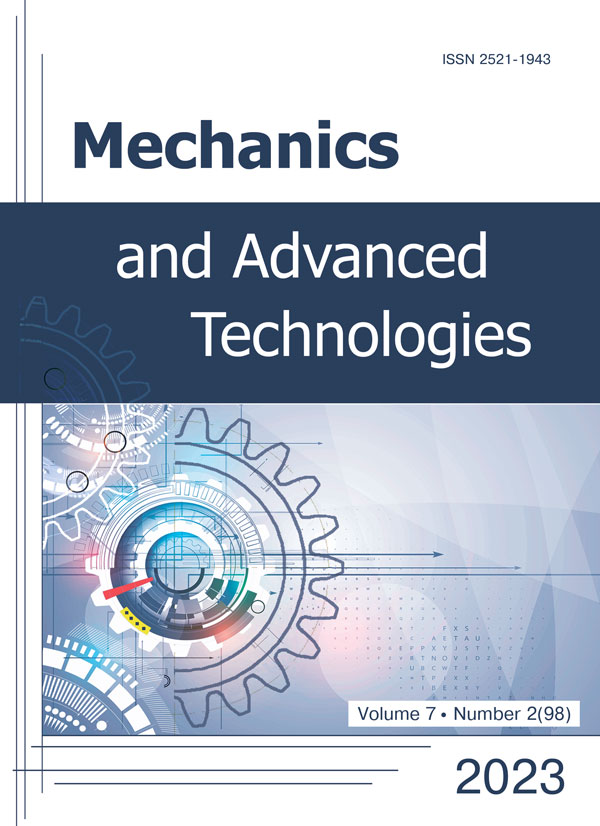Method of matched sections in application to thin-walled and Mindlin rectangular plates
DOI:
https://doi.org/10.20535/2521-1943.2023.7.2.277341Keywords:
Method of matched sections, transfer matrix method, rectangular plate, Mindlin plate, boundary conditions, conjugationAbstract
The paper elaborates the principally new variant of finite element method in application to plate problem. It differs from classical FEM approach by, at least, three points. First, it uses the strong differential formulation rather than the weak one and suppose the approximate analytical solution of all differential equations. Second, it explicitly uses all geometrical and physical parameters in the procedure of solution, rather than some chosen ones, for example, displacement and angles of rotation as usually done in FEM formulation. Third, the conjugation between adjacent elements occurs between the adjacent sections rather than in polygon vertexes. These conditions require the continuity of displacements, angles, moments and forces. Each side of rectangular elements is characterized by 6 main parameters, so, at whole there are 24 parameters for each rectangular element. The right and upper sides’ parameters are considered as output ones, and they are related with lower and left sides ones by matrix equations, which allows to apply transfer matrix method for the compilation of the resulting system of equations for the whole plate. The numerical examples for the thin-walled and Mindlin plates show the high efficiency and accuracy of the method.
References
- V. V. Meleshko, “Bending of an elastic rectangular clamped plate: exact versus ‘engineering’ solutions”, Journal of elasticity, vol. 48, no. 1, pp. 1–50, 1997. DOI: https://doi.org/10.1023/A:1007472709175.
- M. J. Gander and F. Kwok, “Chladni figures and the Tacoma bridge: motivating PDE eigenvalue problems via vibrating plates”, SIAM Rev., vol. 54, no. 3, pp. 573–596, 2012. DOI: https://doi.org/10.1137/10081931X.
- S. Timoshenko and S. Woinowsky-Krieger, Theory of plates and shells, 2nd ed. New York: McGraw-Hill, 1959, 595 p. Available: https://www.cap-recifal.com/ccs_files/articles/cuveaqua1_denisio/Timoshenko_-_Theory_of_plates_and_shells.pdf.
- C. E. Imrak and I. Gerdemeli, “An exact solution for the deflection of a clamped rectangular plate under uniform load”, Applied mathematical sciences, vol. 1, no. 41-44, pp. 2129–2137, 2007.
- X. Liu and J. R. Banerjee, “Free vibration analysis for plates with arbitrary boundary conditions using a novel spectral-dynamic stiffness method”, Computers & Structures, vol. 164, pp. 108–126, 2016. DOI: https://doi.org/10.1016/j.compstruc.2015.11.005.
- P. Moreno-García, J. V. A. dos Santos and H. Lopes, “A review and study on Ritz method admissible functions with emphasis on buckling and free vibration of isotropic and anisotropic beams and plates”, Archives of Computational Methods in Engineering, vol. 25, no. 3, pp. 785–815, 2018. DOI: https://doi.org/10.1007/s11831-017-9214-7.
- C. A. J. Fletcher, Computational Galerkin methods. Berlin, Heidelberg: Springer Berlin Heidelberg, 1984, 310 p. DOI: https://doi.org/10.1007/978-3-642-85949-6.
- B. A. Finlayson and L. E. Scriven, “The Method of Weighted Residual: A Review”, Applied Mechanics Reviews, vol. 19, no. 9, pp. 735–748, 1966. Available: https://faculty.washington.edu/finlayso/MWR-AReview.pdf.
- Q. Wang, D. Shi, Q. Liang and F. Ahad, “An improved Fourier series solution for the dynamic analysis of laminated composite annular, circular, and sector plate with general boundary conditions”, Journal of Composite Materials, vol. 50, no. 30, pp. 4199–4233, 2016. DOI: https://doi.org/10.1177/0021998316635240.
- M. El-Gamel, A. Mohsen and A. Abdrabou, “Sinc-Galerkin solution to the clamped plate eigenvalue problem”, SeMA Journal, vol. 74, no. 2, pp. 165–180, 2017. DOI: https://doi.org/10.1007/s40324-016-0086-9.
- Y. Bai and I. Orynyak, “Application of exponential functions in weighted residuals method in structural mechanics. Part II: static and vibration analysis of rectangular plate”, Mech. Adv. Technol., vol. 5, no. 1, pp. 7–21, Jun. 2021. DOI: https://doi.org/10.20535/2521-1943.2021.5.1.234580.
- E. Ventsel and T. Krauthammer, Thin Plates and Shells: Theory, Analysis, and Applications. Boca Raton: CRC Press, 2001, 688 p. DOI: https://doi.org/10.1201/9780203908723.
- T. J. R. Hughes, The Finite Element Method: linear static and dynamic finite element analysis. Englewood Cliffs, New Jersey: Prentice Hall, 1987, 803 p.
- D. Chapelle and K.-J. Bathe, The Finite Element Analysis of Shells - Fundamentals. Berlin, Heidelberg: Springer Berlin Heidelberg, 2011, 410 p. DOI: https://doi.org/10.1007/978-3-642-16408-8.
- R. W. McCune, C. G. Armstrong and D. J. Robinson, “Mixed‐dimensional coupling in finite element models”, International Journal for Numerical Methods in Engineering, vol. 49, no. 6, pp. 725–750, 2000. DOI: https://doi.org/10.1002/1097-0207(20001030)49:6<725::AID-NME967>3.0.CO;2-W.
- S. Klarmann, J. Wackerfuß and S. Klinkel, “Coupling 2D continuum and beam elements: a mixed formulation for avoiding spurious stresses”, Computational Mechanics, vol. 70, no. 6, pp. 1145–1166, 2022. DOI: https://doi.org/10.1007/s00466-022-02221-7.
- F. Leckie and E. Pestel, “Transfer-matrix fundamentals”, International Journal of Mechanical Sciences, vol. 2, no. 3, pp. 137–167, 1960. DOI: https://doi.org/10.1016/0020-7403(60)90001-1.
- I. Orynyak, Calculation of complex systems by transfer matrix method. Kyiv: “Igor Sikorsky Kyiv Polytechnical Institute”, 2022, 324 p.
- K. H. Lee, G. T. Lim and C. M. Wang, “Thick Lévy plates re-visited”, International Journal of Solids and Structures, vol. 39, no. 1, pp. 127–144, 2002. DOI: https://doi.org/10.1016/S0020-7683(01)00205-0.
Downloads
Published
How to Cite
Issue
Section
License
Copyright (c) 2023 Кірілл Даниленко, Ігор Ориняк

This work is licensed under a Creative Commons Attribution 4.0 International License.
Authors who publish with this journal agree to the following terms:
- Authors retain copyright and grant the journal right of first publication with the work simultaneously licensed under CC BY 4.0 that allows others to share the work with an acknowledgement of the work's authorship and initial publication in this journal.
- Authors are able to enter into separate, additional contractual arrangements for the non-exclusive distribution of the journal's published version of the work (e.g., post it to an institutional repository or publish it in a book), with an acknowledgement of its initial publication in this journal.
- Authors are permitted and encouraged to post their work online (e.g., in institutional repositories or on their website) prior to and during the submission process, as it can lead to productive exchanges, as well as earlier and greater citation of published work











